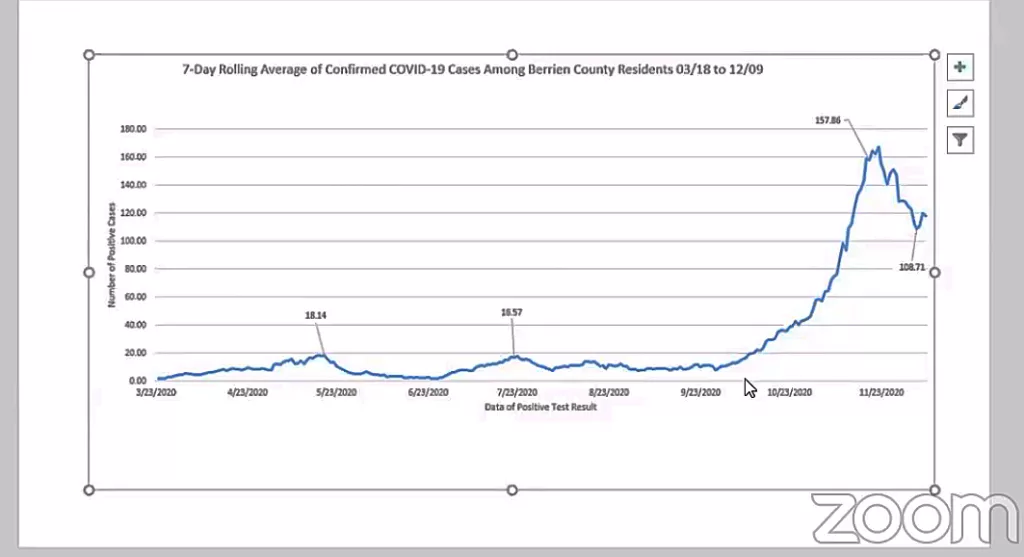Two of Berrien County’s top health leaders shared a bit of good news today in contrast to the coronavirus numbers that had been growing fearsome. In fact, Berrien County Health Department Officer Nicki Britten characterized the recent leveling off of COVID case counts as meaning “we haven’t fallen off the edge of that cliff that we had predicted, but that we stopped just short of that.”
Britten and Spectrum Health Lakeland President Dr. Loren Hamel held a Berrien County Health Department briefing this morning in which Britten shared a graph that shows the number of cases across the whole pandemic going back to March, saying, “You can see the steep increase in the number of cases that we’ve been experiencing, really since the beginning of October, but right around Thanksgiving there started to be a little bit of a leveling off, and a little bit of a decrease here.”
Looking at that chart and figuring how it has trended isn’t all that easy, however, Britten says, “Some of this is a little difficult to fully understand in the right context. There are many things that are changing in our testing environment. There have been some organizations like Spectrum Health Lakeland that have moved towards testing only symptomatic people, so that has reduced the number of people that are eligible for tests. We also know that the number of tests decreased after Thanksgiving, right around that weekend, and has continued to be lower by a few hundred tests per day than it was just before Thanksgiving.” Britten goes on to say, “In light of there being less testing, we are seeing fewer cases, but we know that testing wasn’t driving the increase, so it’s really hard to say. I know people really want to know what’s going on, but sometimes with public health data we need a little bit more time to fully understand the context.”
Despite the leveling off, Britten warns, “The bottom line is we are still sitting at an average of about 120 new cases of COVID per day, and while that is a lot lower than we were projecting before Thanksgiving because the trend has leveled off a bit thankfully, that’s still ten times higher than what we were seeing at the end of September, so we’re still at very elevated levels.” She admits, just the same, that she is “encouraged by what we’re seeing in the trend, and we’re also seeing a bit slower growth in the number of people in the hospital, which is also encouraging as well. Definitely not the ideal scenario, but it seems like we’re not growing as rapidly as we had feared we would be here a couple of weeks into December.”
Dr. Hamel concurs, telling us, “We are officially defined as ‘at capacity.’ That’s kind of a relative term, because that means our regular beds are full. We’ve done a lot to expand our capacity to be able to accommodate both the folks that have COVID and the folks that have medical needs but don’t have COVID, and of course we’re doing our very best to keep those folks isolated.”
Looking at hospitalization numbers, Hamel says, “Our seven day average has gone from the 60-ish range to the 70-ish range, or mid-70’s over the month of November. We’re seeing a day-to-day variation that is pretty significant. We’ve been as low as 56 patients and today we have 70 patients on the in-patient side. We can accommodate 60 to 70 patients. We’re concerned, as we project the future still, that that could grow. We have modified our projections, as we had a worst case scenario up close to 120, and had been revised down to about 105, now revised down to the 90s, and I think that ties entirely to what Nicki was referring to in the county-level data, and it appears that people are doing their best to be careful, and that is paying off, and it’s helping prevent just an intolerable surge, but we’re full, we’re hanging on, and caring for both COVID and non-COVID patients and we can do this for several more weeks as long as things don’t grow dramatically.”
Asked about whether the “pause extension” by the Michigan Department of Health & Human Services is helping, the Health Department’s Britten says, “It’s always hard, especially in a moment, to attribute what is the cause in disease levels in the population. We do know that we’re seeing at least a slowing down of the increasing number of cases that we had, and that is something that again is very good news, it just means we haven’t fallen off the edge of that cliff that we had predicted, but that we stopped just short of that, so there’s still a lot more work, there’s still reason to remain very vigilant.”
Further analyzing the trends, Britten says, “MDHHS had expressed that a big reason for the extension of their orders was to have a little bit more time to understand really what’s going on. What we’re seeing in the data with the decrease in the amount of testing that is happening is a phenomenon that is being seen across the state, where there are just lower levels of testing, and when we have lower levels of testing, we have less information about what is really happening in terms of community transmission, especially, as I mentioned earlier, with many testers across the state changing their criteria for who can be tested. That makes it harder to know what’s going on, so MDHHS did want a little bit more time to be able to see what has been the impact of our interventions over the last few weeks, but not so long that it stretched on for a long period of time, and to give people a little bit of time to respond with whatever comes next before the Christmas holiday.”
So, attempts to once again flatten the curve might be working, but health officials remind everyone to remain vigilant and continue to do what’s right to keep the surge from getting out of control.






